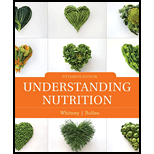
Understanding Nutrition (MindTap Course List)
15th Edition
ISBN: 9781337392693
Author: Eleanor Noss Whitney, Sharon Rady Rolfes
Publisher: Cengage Learning
expand_more
expand_more
format_list_bulleted
Concept explainers
Question
Chapter 2.3, Problem 2.2TI
Summary Introduction
To calculate: Daily value for 1800-kcal diet and revise the Daily value percentage on one of the food labels are given in page 55 in the textbook.
Concept introduction: FDA developed reference values to use in food labels for the specific nutrients. Daily value percentage is the specified serving of key nutrients in food for a 2000kcal diet.
Expert Solution & Answer
Trending nowThis is a popular solution!

Chapter 2 Solutions
Understanding Nutrition (MindTap Course List)
Knowledge Booster
Learn more about
Need a deep-dive on the concept behind this application? Look no further. Learn more about this topic, health-nutrition and related others by exploring similar questions and additional content below.Recommended textbooks for you
- Nutritional Sciences: From Fundamentals to Food, ...Health & NutritionISBN:9781337486415Author:McGuirePublisher:Cengage
 Human Physiology: From Cells to Systems (MindTap ...BiologyISBN:9781285866932Author:Lauralee SherwoodPublisher:Cengage Learning
Human Physiology: From Cells to Systems (MindTap ...BiologyISBN:9781285866932Author:Lauralee SherwoodPublisher:Cengage Learning



Nutritional Sciences: From Fundamentals to Food, ...
Health & Nutrition
ISBN:9781337486415
Author:McGuire
Publisher:Cengage

Human Physiology: From Cells to Systems (MindTap ...
Biology
ISBN:9781285866932
Author:Lauralee Sherwood
Publisher:Cengage Learning

